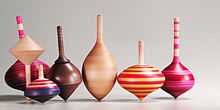Top

A top (also called spinning top or spintop) is a toy designed to be spun rapidly on the ground, the motion of which causes it to remain precisely balanced on its tip because of inertia. Such toys have existed since antiquity. Traditionally tops were constructed of wood, sometimes with an iron tip, and would be set in motion by aid of a string or rope coiled around its axis which, when pulled quickly, caused a rapid unwinding that would set the top in motion. Today they are often built of plastic, and modern materials and manufacturing processes allows tops to be constructed with such precise balance that they can be set in motion by a simple twist of the fingers and twirl of the wrist without need for string or rope.
Characteristics

The motion of a top is produced in the most simple forms by twirling the stem using the fingers. More sophisticated tops are spun by holding the axis firmly while pulling a string or twisting a stick or pushing an auger. In the kinds with an auger, an internal weight rotates, producing an overall circular motion. Some tops can be thrown, while firmly grasping a string that had been tightly wound around the stem, and the centrifugal force generated by the unwinding motion of the string will set them spinning upon touching ground.
The top is one of the oldest recognizable toys found on archaeological sites. Spinning tops originated independently in cultures all over the world.[2] Besides toys, tops have also historically been used for gambling and prophecy. Some role-playing games use tops to augment dice in generating randomized results; it is in this case referred to as a spinner. A thumbtack may also be made to spin on the same principles.
The action of a top relies on the gyroscopic effect for its operation. Typically the top will at first wobble until the shape of the tip and its interaction with the surface force it upright. After spinning upright for an extended period, the angular momentum, and therefore the gyroscopic effect will gradually lessen, leading to ever increasing precession, finally causing the top to topple in a frequently violent last thrash.
There have been many developments within the technology of the top. Bearing tops, with a tip that spins, have been one of the biggest changes. In addition, plastic and metal have largely supplanted the use of wood in tops. Fixed tip tops are featured in National Championships in Chico, California and in the World Championships in Orlando, Florida.
Asymmetric tops of virtually any shape can also be created and designed to balance.[3]
Notable types


- Competing tops
- Dreidel
- Gaming top
- Levitating top
- Perinola, a six-sided top, very similar to the dreidel, that is used for a similar game in Latin America[4]
- Rattleback or celt, a top that reverses its spin direction
- Tippe top
- Trompo, Whipping top
- Wizzzer
See also
References
- ↑ "Gyro-top to stop: Maker closing shop". The Japan News. February 22, 2015.
- ↑ D. W. Gould (1973). The Top. NY: Clarkson Potter. ISBN 0-517-50416-2.
- ↑ Baecher, Moritz; Whiting, Emily; Sorkine-Hornung, Olga; Bickel, Bernd (August 10–14, 2014). "Spin-It: Optimizing Moment of Inertia for Spinnable Objects" (PDF). ACM Conference on Computer Graphics & Interactive Techniques (SIGGRAPH) 2014. Retrieved 15 August 2014.
- ↑ National Recreation Association (1965). Recreation. p. 92.
Further reading
| Wikimedia Commons has media related to Spinning top. |
- Provatidis, Christopher, G. (2012). Revisiting the Spinning Top, International Journal of Materials and Mechanical Engineering, Vol. 1, No. 4, pp. 71–88, open access at http://www.ijm-me.org/Download.aspx?ID=2316 (ISSN Online: 2164-280X, ISSN Print: 2162-0695)
- A forum discussing all things related to the art of Top Spinning: iTopSpin.com
-
 "Top". The New Student's Reference Work. 1914.
"Top". The New Student's Reference Work. 1914.